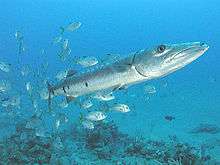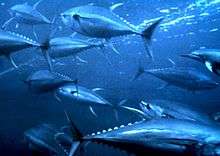Seafood Watch
 | |
| Formation | 1999 |
|---|---|
| Type | 501(c)(3) nonprofit |
| Focus | Sustainable seafood |
| Location | |
Parent organization | Monterey Bay Aquarium |
| Mission | The Monterey Bay Aquarium's Seafood Watch program helps consumers and businesses make choices for a healthy ocean. |
| Website |
www |
Seafood Watch (http://www.seafoodwatch.org/) is one of the best known sustainable seafood advisory lists, and has influenced similar programs around the world. It is best known for developing science-based seafood recommendations that consumers, chefs and business professionals use to inform their seafood purchasing decisions.
Seafood Watch is a program of the Monterey Bay Aquarium. It has roots in the Monterey Bay Aquarium's Fishing for Solutions exhibit which ran from 1997 to 1999 and produced a list of sustainable seafood. It was one of the first resources for sustainable seafood information together with the Audubon Society's What is a fish lover to eat? which also came out in the late 1990s.[1]
Seafood Watch assesses impacts on marine and freshwater ecosystems of fisheries (wild-caught) and aquaculture (farming) operations. The assessments and calculations result in an overall scoring and final rating known as a Seafood Watch Recommendation.
There is currently a seafood watch app for the iPhone and the Android. One of its features allows people to find restaurants and stores near them that serve ocean-friendly seafood.[2]
Sustainable seafood list
The organization's recommendations focus on the North American market, suggesting what seafood is a green "Best Choice," yellow "Good Alternative," or a red "Avoid." The "Avoid" category is for seafood which is overfished or fished or farmed in ways that harm other marine life or the environment. Health alerts for fish with high levels of contaminants (e.g. mercury, dioxins, PCBs) are also noted, although they may appear in any category.
The Seafood Watch website includes regional, country-wide and sushi guides for the United States. Pocket guides are available from the aquarium and further information is on the web site. Several of the regional guides are also available in Spanish. The guides are updated twice annually, while the website is updated more often. Restaurants and retailers are also targeted with an educational program developed by Seafood Watch.[3]
In 2010 Seafood Watch added its “Super Green” list, which features seafood that it is good for human health and does not harm the oceans. The Super Green list highlights products that are currently on the Seafood Watch "Best Choices" (green) list, are low in environmental contaminants and are good sources of long-chain omega-3 fatty acids.
Scientific assessments
The ratings of “Best Choice” (Green), “Good Alternative” (Yellow), or “Avoid” (Red) are based on a numeric score, as detailed in the Seafood Watch Standard for Fisheries and Seafood Watch Standard for Aquaculture.
- “Best Choice” (Green) – Buy first, they're well managed and caught or farmed in ways that cause little harm to habitats or other wildlife.
- “Good Alternative” (Yellow) – Buy, but be aware there are concerns with how they're caught or farmed.
- “Avoid” (Red) – Don't buy, they're overfished or caught or farmed in ways that harm other marine life or the environment.
Seafood Watch assessments and other eco-certification schemes
There are elements of the Seafood Watch Standards and Program and that are unique when compared to other eco-certification schemes and ratings. Seafood Watch:
- Assesses the majority of the seafood on the North American market. Initial estimates cover 70-80% of the total seafood on the U.S. market, by volume.
- Uses a three-tiered approach with the intention of recognizing better and best performers.
- Publishes all assessment results, regardless of score and rating outcome.
- Presses for improvement beyond current best practice.
- Assessments are non-voluntary.
- Standards are structured to assess impacts from farms and fisheries not in isolation, but in the context of the cumulative effects of multiple fisheries and aquaculture farms in the region.
Other initiatives
Seafood Watch partners with zoos, aquariums, science museums, nature centers, and other non-profits to promote sustainable seafood. Its business and culinary initiatives assist seafood buyers, distributors, retailers, food service professionals, and chefs in moving the marketplace towards environmentally responsible fisheries and aquaculture operations. The Monterey Bay Aquarium’s Ocean Conservation Policy team works to advance policies and management measures to improve traceability in the global seafood supply chain; eliminate illegal, unreported and unregulated fishing; strengthen and advocate for fisheries management; and restore shark and Bluefin tuna populations.
Industry criticism
Industry organizations have pushed back against Seafood Watch's efforts. After publication of a sustainable sushi guide, the National Fisheries Institute, a seafood industry trade group, wrote on its blog that the guides were "confusing and contradictory," adding that they didn't fully take into account the economic, environmental and social aspects of seafood sustainability.[4]
See also
- Conservation status
- Overfishing
- Sustainable seafood advisory lists and certification
- Seafood Choices Alliance
- Mercury in fish
References
- ↑ "Background, The Sustainable Seafood Movement". Fishonline.
- ↑ "Seafood Watch App for Android & iPhone".
- ↑ "Seafood Watch Become a Partner information".
- ↑ "Confusing Guidelines". About Seafood. National Fisheries Institute. 2008-10-24.
External links
- Official website
- Seafood Watch Recommendations
- Australia's Sustainable Seafood Guide
- Online Seafood Retailer following Seafood Watch Recommendations

